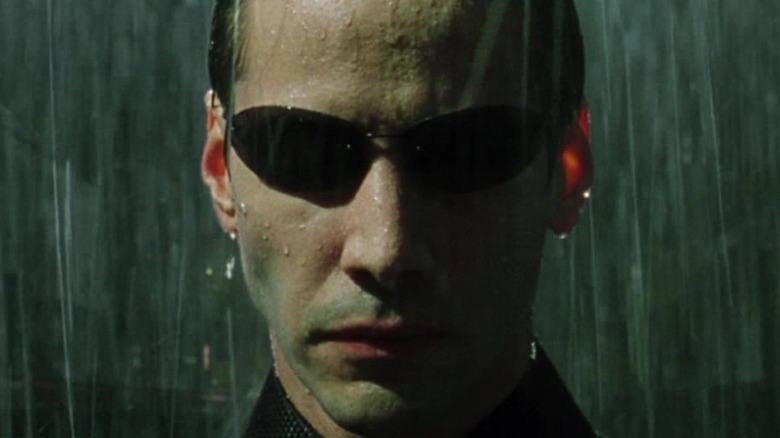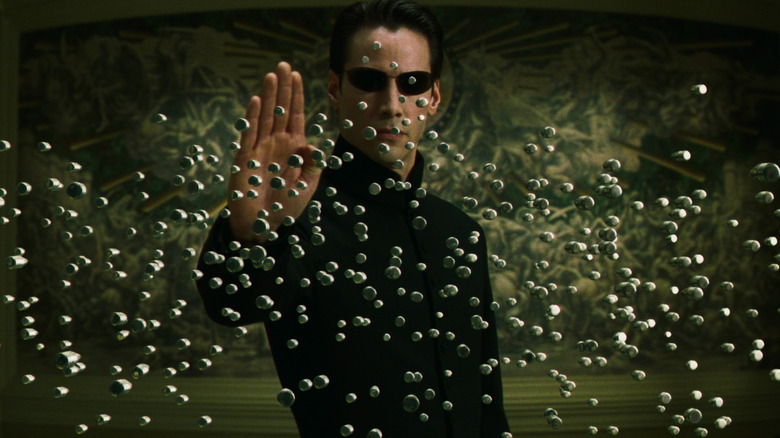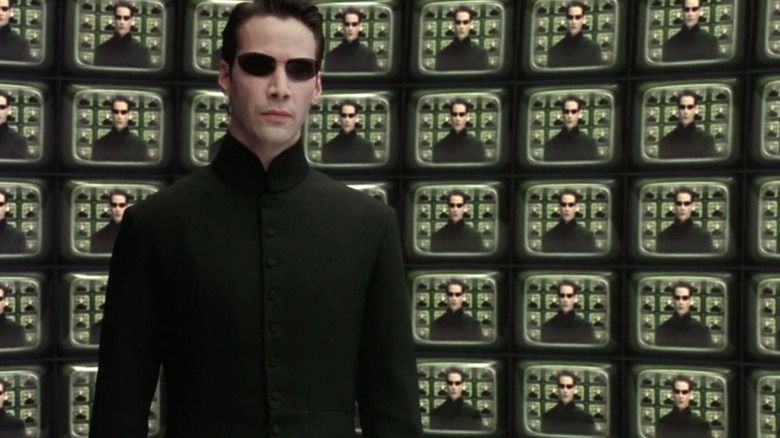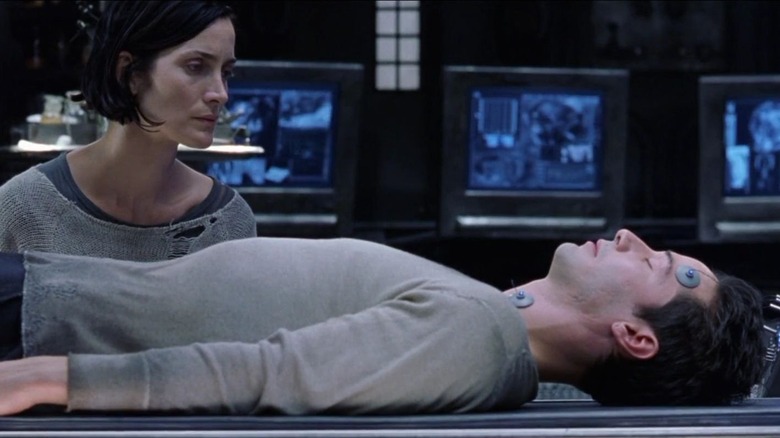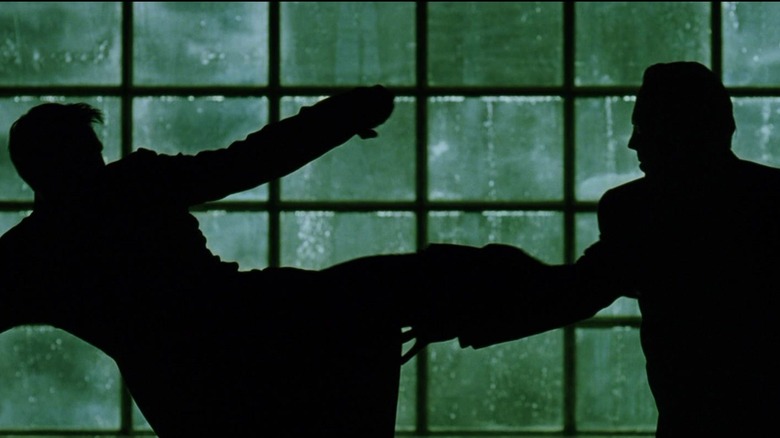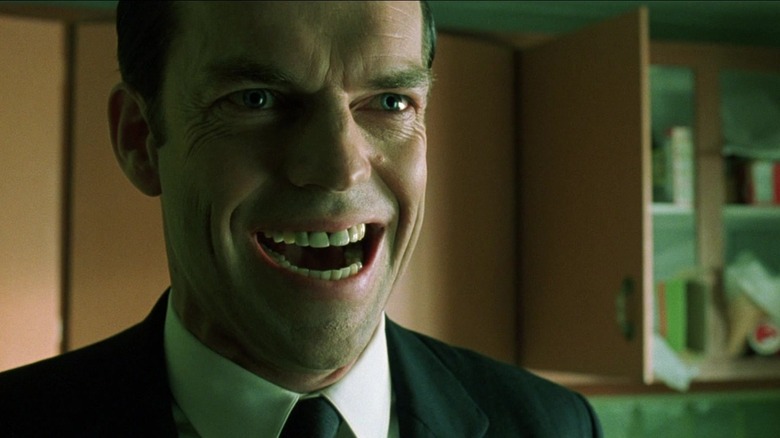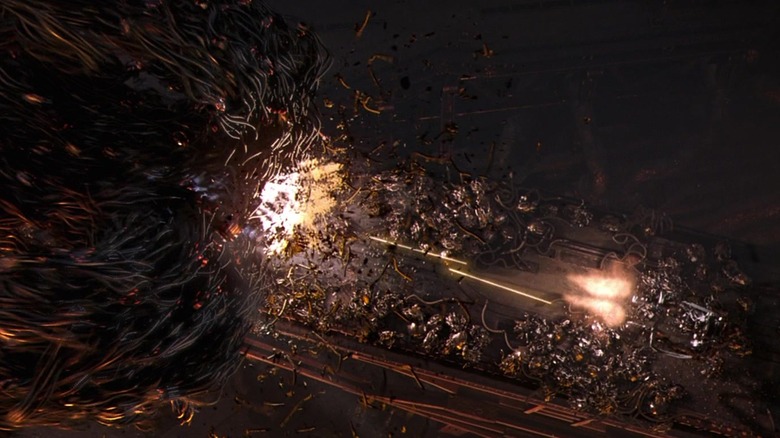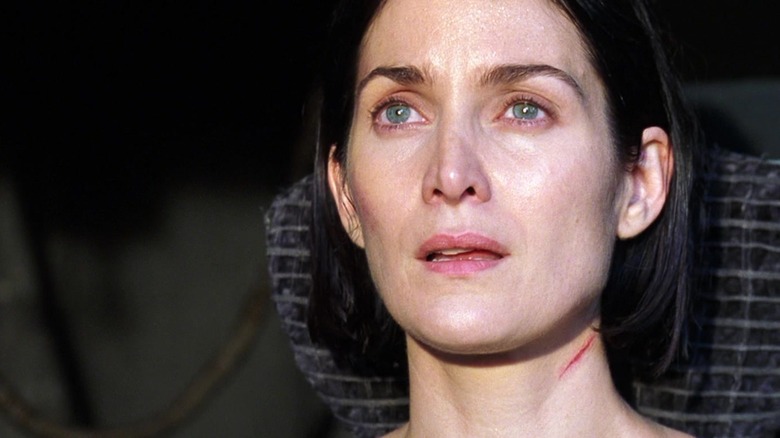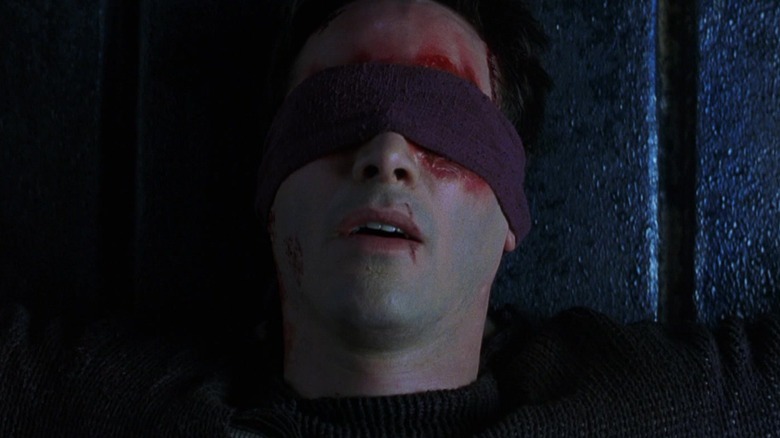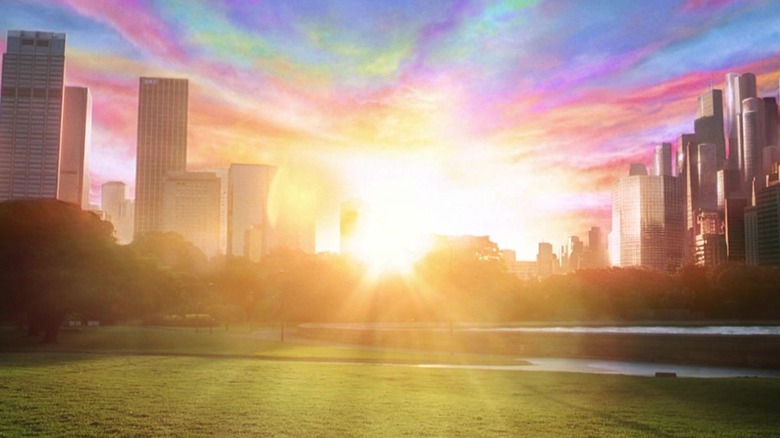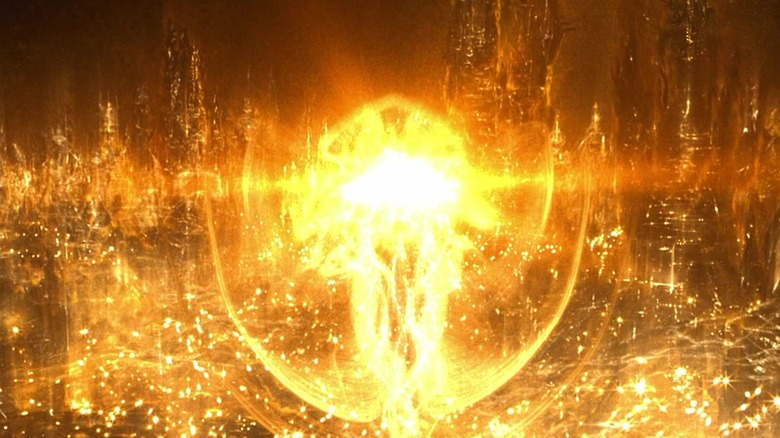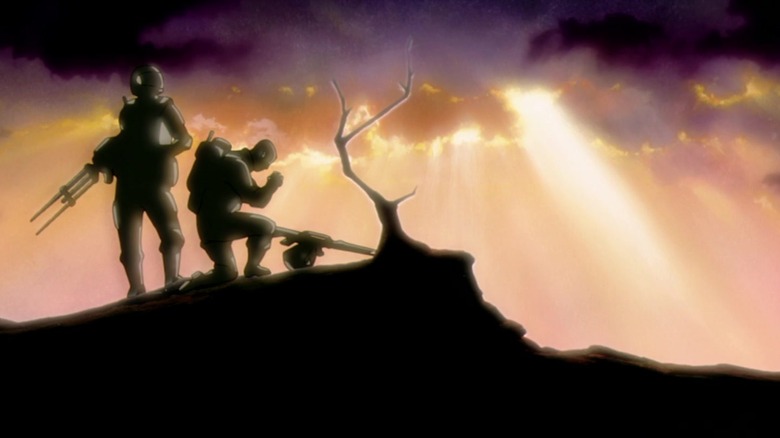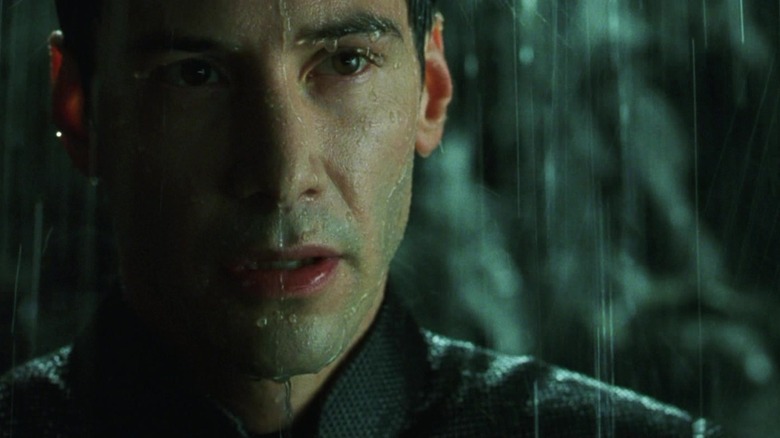Why The Matrix Sequels Are Better Than You Remember
"The Matrix" is one of the greatest sci-fi movies of all time. That's no controversial statement, either. The Wachowskis' game-changing action flick was a hit with audiences when it landed in theaters in 1999, earning nearly $466 million worldwide on a budget of just $63 million. In 2003, Entertainment Weekly described "The Matrix" as "the most influential action movie of its generation," while the movie has appeared on all-time rankings lists by publications from IGN to The Guardian.
"The Matrix Reloaded" and "The Matrix Revolutions" were released in May and November 2003, respectively, and it's probably fair to say that they were not met with quite the same praise as the original. While "Reloaded" did a fine enough job with the critics, "Revolutions" was a critical disaster, and both movies are now utterly reviled in the minds of many film fans. In 2020, for example, Insider gave both movies pride of place on its "Worst Movie Sequels of All Time" list, alongside such disasters as "Caddyshack II" and "Speed 2: Cruise Control." It's a damning indictment on the "Matrix" sequels' reputation.
With the release of "The Matrix Resurrections," however, it might be time to revisit "Reloaded" and "Revolutions." Because, while there certainly is a lot wrong with these movies, the truth is that there's a lot right with them, too. Here's why the "Matrix" sequels are better than you remember.
The action sequences are thrilling
Let's start with one aspect of the "Matrix" sequels that most people would agree is pretty great: the action. Obviously, a lot of the CGI in these movies fails to hold up to modern standards, and some of the action suffers for that — the genuinely atrocious CGI in the infamous "Burly Brawl" is probably the most egregious example.
Put the visual effects aside, however, and you'll find two movies chock-full of some of the best action sequences of the early '00s. The crowning achievement, of course, is the freeway chase in "Reloaded," which was filmed on a $2.5 million fake freeway built by the film's crew on a disused naval base in California. All that money and effort evidently paid off, too, as the finished sequence is an epic, white-knuckle vehicular battle that easily measures up against the chases found in more recent movies, such as "Mad Max: Fury Road" and the "Fast and Furious" franchise.
The martial arts choreography in "Reloaded" and "Revolutions" also holds up to the standard set by the first film. From the château showdown against the Merovingian's cronies to Neo's fight against Seraph to that last stand against Smith in the rain, these movies pull off their hand-to-hand battles with just as much style and grace as "The Matrix." You really can't help but be gripped, and no amount of unfortunate CGI is ever going to change that.
The philosophy is fascinating
All three "Matrix" movies are famous for their takes on the study of philosophy. In a 2006 academic review published by Notre Dame Philosophical Reviews, Texas Tech University's Allan Hazlett wrote that "The Matrix" offered "a deceptive virtual reality scenario burned into our collective cinematic imagination." Philosophy professors no longer had to take pains to actually explain concepts such as Robert Nozick's "experience machine," Hazlett wrote, because they could simply say: "It's like in 'The Matrix.'" In his article, however, Hazlett also describes the dialogue in "Reloaded" and "Revolutions" as "pseudo-profound nonsense designed to intimidate the audience into thinking that something deep is going on."
Still, maybe he ought to have given these two movies another look. Yes, the "Matrix" sequels approach their philosophy in a much more convoluted way than the original. (The notorious Architect scene in "Reloaded" is a particularly offensive example of the sequels' inclination towards nigh-nonsensical expository dialogue.) But many of the philosophical questions asked by "Reloaded" and "Revolutions" are handled more deftly than that particular scene, and there's also a lot to be said for these films centering their stories around philosophy in the first place. If nothing else, you've got to admire the Wachowskis' bravery in tackling such thought-provoking topics within the confines of a tentpole Hollywood blockbuster.
It's a romance for the ages
Despite all that thrilling action and mind-bending philosophical contemplation, "The Matrix" trilogy, at its core, is a love story. Neo may spend three movies fighting the machines and struggling against the deterministic nature of the Paths of The One, but it's his love for Trinity that ends up saving humanity.
Both "Reloaded" and "Revolutions" double down on the romantic arc established by "The Matrix." In the second movie, Neo is given the choice between following the status quo set by the machines or allowing the total extinction of humanity. Instead, he chooses Trinity, breaks free of his purpose, and sets out on a new path — one that ends in "Revolutions" with salvation for Zion and freedom for mankind. The whole trilogy turns around the affection between Neo and Trinity, which, thanks to Keanu Reeves and Carrie-Anne Moss, always feels grounded and believable. It's not exactly a sweeping, dramatic romance — in fact, it's rather quiet and understated — but these movies still make it quite clear that love, above all else, will save the day. And they make that case surprisingly effectively.
There's also something to be said for the palpable sexual energy that pervades both "Matrix" sequels. "Reloaded" has a mass rave/orgy in Zion act as a backdrop to Neo and Trinity's sex scene, while the Merovingian explains cause and effect later in the film by giving a woman an orgasm. Even "Revolutions" has a fight scene take place in what appears to be a fetish club. Considering modern blockbusters have frequently come under criticism for purging themselves of all sexuality, the "Matrix" sequels' more carnal aspects provide a welcome change from the sexless franchise fare of today.
The visuals are gorgeous
The imagery and visuals in the two "Matrix" sequels are pretty at worst and outright iconic at best. While they can't hold a candle to the original — which features some of the coolest shots in the history of action cinema — "Reloaded" and "Revolutions" are nevertheless incredibly attractive movies.
Although your mileage may vary on the decision to give the sequels' scenes inside the Matrix an even more intense green tint than the first film, there can be no doubt that it at least gives them an unmistakable sense of visual flair. Each movie also has at least a few moments in which the imagery really shines through, including Neo's meeting with the Architect in "Reloaded" and the sprawling Machine City in "Revolutions." And then there's Zion, the last bastion of humanity in the real world. The Zion scenes in the sequels take the harder sci-fi aesthetic established by "The Matrix" up to a thousand, coming off as part-"Blade Runner," part-"Lord of the Rings," and part-"Gundam" in the process.
From "Cloud Atlas" to "Jupiter Ascending," one thing that can always be said for the Wachowski Sisters is that they have a real eye for the visually arresting — and that's as clear in the "Matrix" sequels as it is in any of their other films.
Agent Smith is terrifying
"The Matrix" trilogy might tell the story of war between mankind and machines, but the franchise's true villain is a rogue agent whose ultimate goal is the destruction of both sides: Agent Smith. In "The Matrix," Smith is simply the leader of the Agents, albeit one who voices a desire to be something more. In "Reloaded" and "Revolutions," however, he truly comes into his own.
The Smith of the sequels is a terrifying force of nature who tears his way across the Matrix and then the real world, destroying everything in his path. His entry into Bane's body at the end of "Reloaded" provides a tantalizing cliffhanger for the third movie, and actor Ian Bliss gives a performance in the real-world scenes worthy of Hugo Weaving's as the Smith inside the Matrix.
Speaking of Hugo Weaving, credit is certainly due for the sheer, joyous hamminess of his performance as Smith in the "Matrix" sequels. Weaving goes full-throttle on the role in these movies, turning Smith into a snarling, dastardly, scenery-chewing monster — one who is an absolute delight to watch in every single scene. Who could possibly forget Smith's bizarre cackle after assimilating the Oracle or his desperate inability to understand why Neo keeps getting back up during their final fight? Hugo Weaving gives the role of Smith everything he's got during the two "Matrix" sequels and makes both films much better as a result.
They're joyously silly
Both "The Matrix Reloaded" and "The Matrix Revolutions" take themselves pretty seriously, but that doesn't mean you can't have a whole lot of fun watching them. In fact, it's remarkably easy to kick back and enjoy these movies because even if you don't dig the philosophy and can't get past the CGI, you can at least get something out of how unrelentingly over-the-top they are.
"Reloaded" is a movie in which a hundred Smiths take on Neo in a kids' playground, Morpheus fights an SUV with a sword, and the heroes are chased down by machine gun-wielding vampires. "Revolutions" is a movie in which an army of mechas fight a horde of mechanical squids, and Smith/Neo explodes from inside his own sunglasses. A sci-fi/action trilogy about kung-fu fighters battling evil computer programs isn't exactly the time or the place to be pulling punches, and the "Matrix" sequels are gloriously wholehearted in their decadence. Because who needs restraint when you can give Keanu Reeves a sword and make him fight a dude with a trident?
They're filled with quiet, beautiful moments
Amid all the martial arts brawls and epic CGI battles, the "Matrix" sequels also contain a handful of more intimate moments. Unfortunately, many have been forgotten by fans and audiences since the movies were released. This is a real shame, though, because these scenes are some of the best of the whole trilogy.
One example occurs in "The Matrix Revolutions," when Neo and Trinity pilot the Logos out of the clouds and into the real world's sky on their mission to the machine city. Although Neo is blind by this point, Trinity, seemingly for the first time in her life, sees the sun, simply remarking: "Beautiful." It's entirely possible that she's the first human to look at the real sky in many centuries. Although this is just a brief moment in an extended action sequence, it provides one of the trilogy's most affectingly human moments — a soldier, about to give her life for the cause, being shown exactly what it is she's fighting for.
Another example can also be found in "Revolutions," when Oracle, Seraph, and Sati watch the sun rising over the Matrix. Sati's sunrise is filled with purples, greens, and blues, while the distinctive green hue that previously characterized the Matrix itself is gone. Coupled with the Oracle's belief that Neo will come back one day, this scene is permeated with a sense of earnest hope that had never been present in the story.
Moments like these are pretty sporadic in the two "Matrix" sequels, of course, but they still show that these movies are more than just kung-fu fights and robot wars. There's real heart to them, too.
The ending feels earned
Although the "Matrix" trilogy ends on a hopeful note for mankind, things turn out less well for many of the individual characters. Setting "The Matrix Resurrections" aside, the seemingly definitive fates of both Neo and Trinity put a particular downer on the ending of "The Matrix Revolutions." Trinity is killed in the crash of the Logos before reaching the Machine City, while Neo is blinded in his fight with Bane/Smith before sacrificing himself to bring down Smith for good. Meanwhile, the victory in Zion (if it can be called a victory) has come at a terrible cost, with Captain Mifune and countless other humans killed in the battle against the machines. So, yeah — bad times all around.
The thing is, though, that these endings work in the trilogy's favor. Peace with the machines comes at such a cost that it feels like it has actually been earned by the protagonists. It would have seemed cheap to have Neo save the world, come back home, and ride into the sunset with Trinity. Instead, the ending of "The Matrix Revolutions" is tinged with melancholy and sacrifice and made all the more powerful for it. When the Architect and the Oracle wonder how long the peace will hold, you really want it to because these characters — who you've followed for three movies — have died in order to make it happen. Killing Neo, Trinity, and most of Zion's warriors might be unsatisfying if you were hoping for a more traditional happy ending to the trilogy, but that doesn't mean it's not incredibly effective.
They choose peace over destruction
More can be said about the ending to the "Matrix" trilogy — specifically, the way in which it eschews the kind of ending commonly found in action franchises, instead opting for a less predictable and more thought-provoking resolution.
The obvious ending for "The Matrix Revolutions" and the trilogy as a whole would be for the humans to achieve a stunning victory over the machines. Zion would be saved, Smith destroyed, and the machines cast down, putting a final end to the war that had plagued humanity for hundreds of years. But that's not what happens. Instead, Neo fights and dies for a peace treaty — a fragile compromise between the machines and mankind that is beneficial to both sides. Specifically, humans inside the Matrix are freed if they so choose, Smith is removed from the equation, and Zion ends its war with the machines.
For Neo to give his life to foster peace rather than ensure a destructive victory is an incredibly refreshing path for a blockbuster trilogy to take during its final act. It may not be entirely gratifying, and it certainly won't satiate your bloodlust if you're a fan of no-holds-barred action movies, but it sends a truly powerful message regardless: that sometimes the only way to resolve a conflict is through understanding and compromise.
They deconstruct the Chosen One trope
The original "Matrix" film revolves around the concept of messianism. Neo is brought into the real world and told that it's his destiny to deliver mankind from slavery under the machines; by the end of the movie, he has fully embraced this role, becoming the god-like "One" in the process. It's a good story, but let's face it — it's hardly anything new. People have been telling "Chosen One" stories for as long as stories have existed, and, in recent decades, franchises from "Star Wars" to "Harry Potter" have followed suit.
But the "Matrix" sequels swerve this tried and tested character arc and take Neo down a far less familiar path. "The Matrix Reloaded" and "The Matrix Revolutions" totally deconstruct the Chosen One narrative, explicitly telling Neo that he is not only the sixth One to have been chosen, but that his role as the messiah is simply a facet of a predetermined cycle that has been designed to maintain the status quo.
This revelation is subversive in the best possible way, and it feeds brilliantly into the revelation of the "Matrix" trilogy's true savior: Neo and Trinity's love for one another. Neo rejects his role as faux-messiah, chooses Trinity over mankind, and, in a roundabout way, becomes a kind of messiah anyway, making peace with the machines in exchange for the freedom of the human race. It's a fascinating twist on a tale as old as time.
They went beyond the movies
If you were around in 2003, you're probably aware of the fact that the story of the Matrix wasn't limited to the silver screen. In fact, the Wachowskis expanded the franchise into a number of tie-ins and spin-offs. These include "The Animatrix," an anthology of nine animated short films telling stories related to the main saga, such as the first war against the machines. There was also "Enter the Matrix," an action-adventure video game that followed Niobe and Ghost during the same timeframe as "The Matrix Reloaded," as well as a series of comic books that ran from 1999 to 2003. Finally, "The Matrix Online" was an MMORPG released in 2005 and set after the end of "The Matrix Revolutions" that carried the story into the future.
These were more than mere money-making enterprises for Warner Bros. and the Wachowskis, however. While it was certainly possible to watch only "Reloaded" and "Revolutions" and still get a lot out of the "Matrix" saga, if you really wanted to experience the full story, you needed to explore every other aspect of the franchise. Perhaps nowhere is this clearer than in "The Matrix Online," which actually features the canon death of Morpheus. With the latter elements of the "Matrix" story, the Wachowskis created and produced a multimedia epic that stretched far beyond the confines of cinema. You can't fault them for their ambition.
They're ambitious
Okay, so maybe you disagree with everything we've said. Maybe you despise the "Matrix" sequels. The dialogue is nonsensical, the CGI is a mess, the endless philosophizing is torturous; you'd rather chew your own eyes out than sit through these two movies ever again. And hey, that opinion is valid too. At the very least, however, one thing you'd hopefully agree on is that these movies swung for the fences.
The Wachowski Sisters may not have made masterpieces in "The Matrix Reloaded" and "The Matrix Revolutions," but they certainly made something interesting: a two-part sci-fi/action/martial arts epic driven by the struggle for free will and the power of true love. It is also, according to the Wachowskis themselves, an explicit trans allegory about "the desire for transformation [...] coming from a closeted point of view." And, above all that, they also managed to throw a few vampire ghosts into the mix. They may not be perfect, but the "Matrix" sequels are never ashamed of themselves, never afraid to be heartfelt and ridiculous, and never willing to play it safe. Hollywood would be a better place if more movies could say the same.
